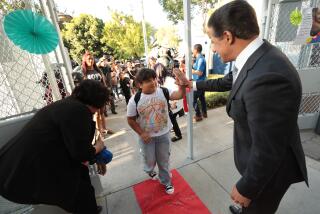Eager Schools to Spend Rewards on Learning
- Share via
New laptop computers. Kid-friendly furniture. Books for classroom libraries. White boards to replace dusty blackboards.
These are among the myriad ways that California public schools plan to spend the $227 million in taxpayer-funded rewards that will soon begin flowing under Gov. Gray Davis’ school accountability program.
Today, the California Department of Education will post on its Web site the list of 4,502 schools that will receive this windfall, along with the amount each will get. The schools qualified by meeting or exceeding state-imposed improvement targets on the 2000 Academic Performance Index, which is based on schools’ scores on the Stanford 9, a standardized basic skills test.
Although Davis originally intended that qualifying schools get $150 per student, so many schools hit their goals that the per-student amount was slashed to less than half that amount: $63.
Still, cash-strapped schools were gleeful at the prospect of any extra spending money.
At the 825-student Addams Elementary School in Lawndale, “Fifty thousand dollars allows us to do some things that can make a difference,” said Principal Frank Noyes. “That’s pretty nice money.”
Like his counterparts statewide, Noyes has been working with parents, teachers and others on Addams’ 10-person school governance council to determine priorities. With literacy and technology at the top of the list, Noyes said he expects the school to buy new computers with wireless networking for classrooms, as well as books for classroom libraries.
Paula Willebrands, principal of Stevenson Elementary School in Burbank, said the school plans to save half of its anticipated $30,000 in reward money to build a computer lab in 18 months, after the school has been modernized.
Called the Governor’s Performance Award, this first batch of reward money comes without restrictions.
But most schools seem inclined to use the money to improve the learning environment. Schools in Palos Verdes Peninsula Unified School District, for instance, expect to pay for teachers’ training and for such simple changes as replacing chalkboards with white boards.
Even though Davis’ proposed budget calls for $350 million to continue this program, “we’re treating this as one-time money,” said Ira Toibin, Palos Verdes Peninsula’s superintendent, echoing the views of several other school officials.
Still to be divided this year are two other pots of reward money--both of which involve teachers’ bonuses. The larger chunk is $350 million in one-time funds to be doled out, probably in April, to qualifying schools and all the teachers, custodians and others who work at them.
The third program, the most controversial, will disperse $100 million in big-money bonuses to teachers, counselors and administrators at schools in the bottom half statewide that showed hefty gains in 2000 Stanford 9 scores.
Under that program, 1,000 teachers and administrators will receive $25,000 each; 3,750 staff members will get $10,000 each; and 7,500 will get $5,000 each. That money will become available between late April and early summer.
The list of schools and award amounts will be posted at https://www.cde.ca.gov/psaa/awards.
More to Read
Sign up for Essential California
The most important California stories and recommendations in your inbox every morning.
You may occasionally receive promotional content from the Los Angeles Times.











